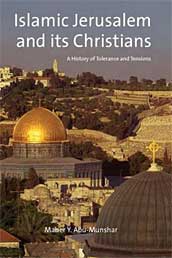|
Reviewed by Daniel G. Shaw, Ph.D., Professor of Philosophy, Pikes Peak Community College Muslim treatment of Christians at the time of the first conquest of Jerusalem under the caliph Umar in the 7th century and at the time of the city’s re-conquest by Saladin in the 12th century is the focus of Maher Y. Abu-Munshar’s recent bookIslamic Jerusalem and its Christians: a History of Tolerance and Tensions. Underneath this theme, however, lies the author’s main purpose, which is to introduce to a broader reading public to a field of study coined “Islamicjerusalem studies” by Professor Abd al-Fattah El-Awaisi, Founding Principal and Vice-Chancellor of Al-Maktoum Institute in Dundee, Scotland. Abu-Munshar sets out to correct what he believes is an abiding assumption: that “Among western historians, the history of Islamic Jerusalem during the two periods under discussion has suffered from falsification, and has been strongly attacked by a number of authors who consider that Muslim policies contained much oppression and aggression towards non-Muslims.” The book is divided into three parts, starting with a chapter on “Islamic Sources and the Treatment of Non-Muslims,” which seeks to educate the reader in the unfamiliar historiography of Islamic scholarship. Here we find a catechism in core Islamic teachings about how Muslims ought to treat Christians drawn from the Qur’an, the Hadith, and the Fiqh legal texts. We are introduced to the so called Constitution of Medina (sahifat al-Madinah) as a prototype for harmonious relations between Muslims and non-Muslim “tolerated” peoples. This document, supposedly from the time of the Prophet, would, the author believes, set the tone for such future interactions in Jerusalem. The second and third chapters go on to address the treatment of Christians at the time of the Caliph Umar’s conquest of the city. The core text under review for this period is the so called “Pact of Umar,” a text likely written at a far later date, as the author recognizes. Indeed, his purpose in acknowledging this rather harsh treaty is to insist that the Pact is “utterly foreign to the mentality, thoughts and practice” of Umar. Unfortunately, he relies on the historiography of chapter one for his assessment of the character of Umar, a serious problem in these early chapters, about which more will be discussed shortly. In the final chapters, Abu-Munshar analyzes the re-conquest of Jerusalem by Saladin, and the Muslim treatment of Christians at that time. After a short primer on the reasons for the Crusades and the biography of Saladin, we are given a history of the commander’s relations with Christians from the perspective, again, of primarily Muslim scholars. Key texts in this section include four different reports of Saladin’s negotiations with the Crusaders for the surrender of the city. The section ends with a paean to the noble character of the great warrior. As an extension of “Islamicjerusalem Studies” this book views the history of Jerusalem “from and Arab and Muslim point of view” to the neglect of important western scholarship. Ignored, for example, is the recent scholarship of western scholars like Mark R. Cohen, R. Fletcher, Hugh Goddard, Efraim Karsh and others. Instead, Abu-Munshar, to the extent that he does include western scholarship, calls upon the now ancient work of scholars like A.S. Tritton, or upon more recent yet highly uncritical western assessments by writers like Karen Armstrong and John Esposito. To a very large extent, at least in the early chapters of the book, he relies far too heavily on the opinions of El-Awaisi. In so doing, Abu-Munshar succumbs to the unfortunate tendency of many scholars from the Islamic world to equate the traditions of the Hadith and Sira literature with historical fact. His opening chapter makes this evident. By pointing to the Qur’an and Hadith as primary evidence for how Muslims should treat Christians, and drawing from much later Muslim historians who do the same, Abu-Munshar attempts (with apologies to David Hume) to derive an “is” from an “ought.” His characterization of the “mentality, thoughts and practice” of Umar, for example, reflect piety, not history. This author has a great deal of difficulty distinguishing the two. This, of course, points to the far larger issue of what constitutes historical evidence. As stated, the author seeks to counter earlier western historical accounts. Yet in choosing not to seriously articulate those accounts and instead progress directly to Islamic accounts, he sets up something of a straw man argument. A more successful, less polemical, and more interesting approach would have been to take on key western positions about these two periods one at a time and respond to each from the perspective of Muslim historians. The clash of approaches is implied in this work but not elucidated. More disturbing, in this and similar “historical” pieces by Muslim authors, is the “assumed eternalism” of the Qur’an and Hadith as reliable evidence for later historical periods. Because these sources say Muslims must treat Christians in a certain way thus becomes proof, for these scholars, that Muslims indeed did treat Christians in that way. Again, piety replaces history. Nevertheless, this work has value in providing western readers insights into the way Muslims think about history. It also serves to provide a fine bibliography of Muslim historians who address the history of Islam in Jerusalem in these two periods. As a true critical assessment of Muslim-Christian relations in Jerusalem under Muslim rule, however, Abu-Munshar’s reliance on “cherry-picked” accounts and sources leads him to come up short. |


 Islamic Jerusalem and its Christians: a History of Tolerance and Tensions
Islamic Jerusalem and its Christians: a History of Tolerance and Tensions 